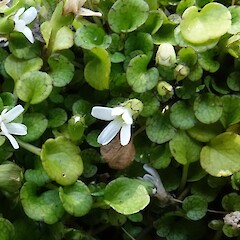Ourisia modesta
Common name
creeping foxglove
Synonyms
None
Family
Plantaginaceae
Flora category
Vascular – Native
Endemic taxon
Yes
Endemic genus
No
Endemic family
No
Structural class
Herbs - Dicotyledons other than Composites
NVS code
The National Vegetation Survey (NVS) Databank is a physical archive and electronic databank containing records of over 94,000 vegetation survey plots - including data from over 19,000 permanent plots. NVS maintains a standard set of species code abbreviations that correspond to standard scientific plant names from the Ngä Tipu o Aotearoa - New Zealand Plants database.
OURMOD
Chromosome number
2n = 48
Current conservation status
The conservation status of all known New Zealand vascular plant taxa at the rank of species and below were reassessed in 2017 using the New Zealand Threat Classification System (NZTCS) – more information about this can be found on the NZTCS website. This report includes a statistical summary and brief notes on changes since 2012 and replaces all previous NZTCS lists for vascular plants.
Please note, threat classifications are often suggested by authors when publications fall between NZTCS assessment periods – an interim threat classification status has not been assessed by the NZTCS panel.
- Conservation status of New Zealand indigenous vascular plants, 2017 . 2018. Peter J. de Lange, Jeremy R. Rolfe, John W. Barkla, Shannel P. Courtney, Paul D. Champion, Leon R. Perrie, Sarah M. Beadel, Kerry A. Ford, Ilse Breitwieser, Ines Schönberger, Rowan Hindmarsh-Walls, Peter B. Heenan and Kate Ladley. Department of Conservation. Source: NZTCS and licensed by DOC for reuse under the Creative Commons Attribution 4.0 International licence.
2017 | Threatened – Nationally Critical | Qualifiers: DP, PD, Sp
Previous conservation statuses
2012 | Threatened – Nationally Critical | Qualifiers: Sp
2009 | Threatened – Nationally Critical | Qualifiers: Sp
2004 | Gradual Decline
Distribution
Endemic to the North, South and Stewart Islands. In the North Island known only from one site in the North West Ruahine Ranges, where it has not been seen recently.
Habitat
Beech forest alongside rivers, usually in seepages or on poorly drained terraces amongst leaf litter or in muddy hollows, sometimes associated with stream and river banks, or in flushes within subalpine scrub.
Wetland plant indicator status rating
Information derived from the revised national wetland plant list prepared to assist councils in delineating and monitoring wetlands (Clarkson et al., 2021 Manaaki Whenua – Landcare Research Contract Report LC3975 for Hawke’s Bay Regional Council). The national plant list categorises plants by the extent to which they are found in wetlands and not ‘drylands’. The indicator status ratings are OBL (obligate wetland), FACW (facultative wetland), FAC (facultative), FACU (facultative upland), and UPL (obligate upland). If you have suggestions for the Wetland Indicator Status Rating, please contact: [Enable JavaScript to view protected content]
FACW: Facultative Wetland
Usually is a hydrophyte but occasionally found in uplands (non-wetlands).
Detailed description
Perennial, creeping herb up to 70 mm tall, with ascending inflorescences and repent leaves; stems 0.6–1.3 mm thick; internodes 6–22 mm long, clearly separate, glabrous or eglandular hairy. Leaves opposite; petiole 4.5–33.7 × 0.4–1.2 mm, mostly glabrous, leaf lamina 4.0–15.0 × 4.6–12.3 mm, broadly ovate, circular, or elliptic, apex rounded, base truncate or weakly cordate, sometimes slightly cuneate, margin subentire or irregularly notched, upper surface glabrous, finely and densely punctate, undersides glabrous, densely punctate. Inflorescence 25–90 mm long, racemose, ascending, bracteates, with 1–2-flowering nodes per inflorescence, 2 bracts and 1 flower per node, and c. 1–2 flowers per raceme; peduncle 0.6–1.1 mm wide, eglandular hairy. Floral bracts 3.7–9.3 × 3.9–9.3 mm, decreasing in size toward inflorescence apex, petiolate to subsessile, broadly ovate to ovate, rarely elliptic to circular, margin subentire or irregularly notched, glabrous or sparsely eglandular hairy on margins and petiole, otherwise upper surface densely punctate. Flowers 5.7–8.9 × 2.5–7.2 mm, white. Pedicel 2.3–15.8 mm long, sparsely eglandular hairy. Calyx 3.7–8.2 × 2.7–6.7 mm, irregular, glabrous, densely punctate, rarely sparsely eglandular hairy. Corolla 6.6–9.0 × 7.7–9.0 mm, bilabiate, tubular-funnelform, glabrous or rarely externally furnished with sparse, short, eglandular hairs; tube 3.3–6.3 × 2.8–3.8 mm at apex; corolla lobes 1.7–3.5 × 0.9–2.0 mm, slightly spreading, slightly obcordate, emarginated or apical margin undulate. Stamens 4, two long stamens 4.5–5.3 mm, two short stamens 2.6–4.6 mm, anthers reniform to horse-shoe-shaped, staminode 0.3–0.4 mm long or absent. Style 2.2–3.9 × 0.2–0.5 mm, capitate or emarginated; ovary 1.5–2.3 × 1.3–1.7 mm. Capsules 4.4–5.2 × 4.2–6.0 mm, glabrous, fruiting pedicels 17.0–31.3 mm long. Seeds 0.7–0.8 × 0.5–0.7 mm.
Similar taxa
Easily confused with sterile specimens of Viola filicaulis from which it is most easily identified by having opposite, exstipulate rather than alternate stipulate leaves.
Flowering
December - January
Flower colours
White
Fruiting
January - February
Propagation technique
Difficult and should not be removed from the wild.
Threats
The exact extent of decline or the degree of threat this small herb actually faces is unclear. It would appear to have recently gone extinct in its only known North Island location, perhaps through natural succession to taller plants. In the South Island some populations have been lost as a result of weeds spreading into its habitat. However, as the species is very cryptic it is easily overlooked so it is possible that some of those populations believed to have gone are still there, while the exact distribution of the species remains unclear.
Etymology
ourisia: After Ouris, governor of the Falkland Islands
modesta: Mild or modest
Where To Buy
Not commercially available.
Attribution
Fact Sheet Prepared for NZPCN by: P.J. de Lange 28 October 2009. Description based on Meudt (2006) - see also de Lange et al. (2010).
References and further reading
de Lange, P.J.; Heenan, P.B.; Norton, D.A.; Rolfe, J.R.; Sawyer, J.W.D. 2010: Threatened Plants of New Zealand, Christchurch, Canterbury University Press. 471pp
Meudt, H.M. 2006: Monograph of Ourisia (Plantaginaceae). Systematic Botany Monographs 37. 188pp.
NZPCN Fact Sheet citation
Please cite as: de Lange, P.J. (Year at time of access): Ourisia modesta Fact Sheet (content continuously updated). New Zealand Plant Conservation Network. https://www.nzpcn.org.nz/flora/species/ourisia-modesta/ (Date website was queried)
















